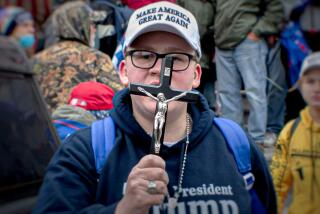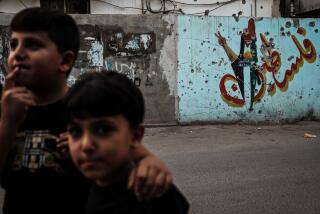A great divide and how it began
- Share via
It is astonishing that such a superb history of the myths and realities of Christian-Muslim relations should appear when we need it most. “Infidels” exposes the legends and the language that survive the facts and the conscious distortions on both sides of the age-old conflict.
Andrew Wheatcroft’s prime example of the language of what he calls maledicta is the misuse of the words “crusade” and “jihad.” Each word conjures up opposite images to Christians and Muslims. The word “crusade” was first used by Europeans to describe the invasions of the Holy Land, beginning in 1099. The image that the word creates among Christians is of a noble knight in shining armor. To the Muslim, the image is of a brutish invader, heavily armed, with a cross on his chest and a broadsword in hand, intent on rape and robbery and from whom his ancestors had to hide underground to escape. It is the same with “jihad” -- to the Muslim, it suggests a bold warrior defending Islam with his life; to the Christian (and to the politician who seeks to influence by rousing fear), a fanatic terrorist falsely representing his religion.
“This book,” Wheatcroft writes at the outset, “is about enmity, how it was created and how it is sustained.” To illustrate the clash between civilizations, he takes his examples from the beginning of Islam in the 7th century as well as from the love, hate and manipulation that one sees everywhere in the world today.
Wheatcroft first concentrates on the 16th century battle of Lepanto, when the Christian navy faced the Ottoman Turkish fleet led by the great admiral Ali Pasha. Religion may have been the spin used to justify the battle, but mastery of the vast commercial traffic of the Mediterranean Sea was its true aim. Wheatcroft gives a fine, colorful description of the meeting between the lumbering, high-prowed ships of Spain and Venice and the sleek, brightly painted galleys of the Turkish fleet. If there were nothing else but the story of the battle, it alone would make wonderful reading. But he leads gently toward the maledictive legends spread by the two religious sides in the battle. These legends reach back to the beginnings of Christianity and Islam, whose mutual distrust and hatred fed on the past and grew into monsters.
Wheatcroft does not mention the 300 years of ferment and punishment for “heresy” that divided Christianity even before the ministry of the prophet Muhammad. It was the sectarian division over the nature of Jesus Christ, man or God, that spawned the Council of Nicea in AD 330. The orthodox creed left adherents of the Arian heresy (which said Jesus was a man, not one of the aspects of God) with beliefs that must have been fertile ground for Islam. Muhammad’s teachings, which said Jesus was the last of the prophets, echoed the Arian heresy.
Wheatcroft’s study also focuses upon the fall of Granada in 1492, the last kingdom of the Muslims in Spain, which led to the expulsion of the Jews and the Spanish Muslims. The Muslim occupation in Spain had lasted for seven centuries. The post-surrender uprising of the Muslims in the mountains beyond Granada was given as the excuse for the expulsion of all Muslims who did not convert to Christianity. The revolt was caused by the vicious betrayal of the kingdom’s surrender by Cardinal Jimenez de Cisneros, one of the most enlightened church fathers in Spain and a fanatical conservative Christian (as was Queen Isabel). After several years of a fairly peaceful government, he set up the Inquisition in Granada, and the fires of the auto-da-fe burned in the Bibrambla, the main square of Granada. These two true histories, Granada and the battle of Lepanto, became more than their actions. They entered into myth, rising from emotional memories of the people and from careful manipulation.
The next hornet’s nest that Wheatcroft examines is the hatred that, starting centuries ago with Turkish occupation, still divides the Balkans. What a subject to face -- it is the perpetual Christian-Muslim border, so painfully tangled, almost from mile to mile, mountain to mountain. The Muslim-Christian war has never ended, and the battle lines have remained drawn since the battle of Kosovo in the 14th century. The story is as snarled as the national and cultural borders that wind through villages a few miles apart, through towns and farms, from neighbor to neighbor.
Having educated the reader to the certainty that opinion is not necessarily fact, Wheatcroft turns to the relationship between the United States and the Middle East. He quotes three presidents whom he most admires for their control of the enmities of their times. The first is Abraham Lincoln, whose “with malice toward none, with charity for all” could have changed the face of the country further, had he not been assassinated. Malediction replaced what Lincoln had called “the better angels of our nature.” The second, Theodore Roosevelt, is a surprise to those of us whose image of him is of a strutting, chauvinistic man. Wheatcroft recognizes in him, and his dictum, “Speak softly and carry a big stick,” the mastery of words of a prolific writer. His influence on his distant cousin Franklin Delano Roosevelt was vital. One finds it in FDR’s technique of being in touch with the American people, of speaking softly, in his fireside chats with the American people on radio. It was FDR -- with his timing and understanding of how he was heard -- who helped save the nation in World War II from vituperation and massive cultural hatred of the enemy. But he did not live to see the results of his genius for communication in the healing miracle of the Marshall Plan.
Every previous chapter of “Infidels” is essential to understanding the last two chapters, which are about the United States, here and now, and its influence on the world. The president and his father are, according to Wheatcroft, irresponsible speakers at a time when clarity could save lives. Bush’s use of “crusade” is an example of beating the old hornet’s nest in ignorance of its worldwide image. Professor George Kittredge of Harvard, the great Shakespearean expert, is said to have told a student who demanded the right to his own opinion, “No man, sir, has a right to his opinion until he makes himself acquainted with the facts.” With what passionate and noisy ignorance today we again hear the age-old maledicta of hatred being used.
Wheatcroft’s handling of quotes from many, including Arianna Huffington, Aleksandr Solzhenitzyn, the 16th century text “Malleus Malleficarum” and the Internet, displays his mastery of a great range of material. Who else has the quite appropriate and surprising ability to choose from such a huge landscape of examples? There is neither prejudice nor intellectual snobbery, nor opinions masked as fact in this so-needed book. The democracy of speakers on both sides is the marvelous gift from a marvelously gifted scholar. *
More to Read
Sign up for our Book Club newsletter
Get the latest news, events and more from the Los Angeles Times Book Club, and help us get L.A. reading and talking.
You may occasionally receive promotional content from the Los Angeles Times.







